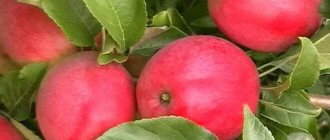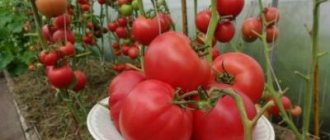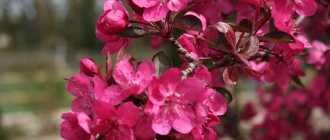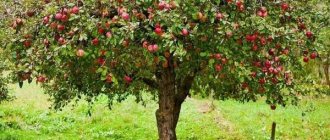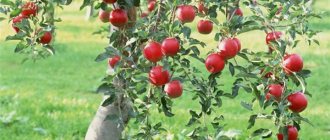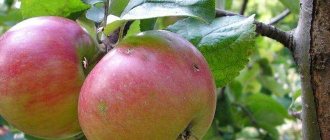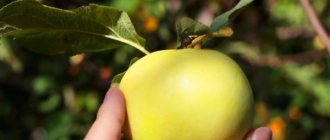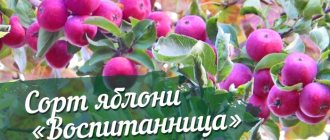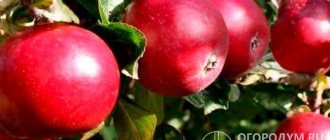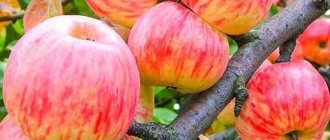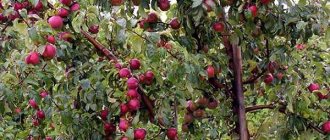Apple tree Malinovka
In our country, a fairly common crop that can be found everywhere is the apple tree.
When they are seriously involved in growing fruit trees, much attention is paid to the correct selection of the plant variety and, of course, the necessary care of the crop. If you neglect these rules, you can get a much smaller amount of harvest and, accordingly, losses associated with this. This article will describe in detail the Malinovka apple variety, which may be suitable for many gardeners.
Malinovka apple tree: description and characteristics, selection of seedlings, planting and care, photo
On the territory of our country, a fairly common crop that can be found everywhere is the apple tree.
When growing fruit trees in earnest, much attention is paid to the correct selection of the plant variety and, of course, the necessary care of the crop.
If you neglect these rules, you can get a much smaller amount of harvest and, accordingly, losses associated with this. This article will describe in detail the Malinovka apple variety, which may be suitable for many gardeners.
Apple tree Malinovka (Suislepskoe)
Malinovka apple tree, other names: Suislep, Suislep, Suisleper - this is an early summer variety.
The tree is medium in size, the crown is dense and spherical. The branches are raised, dark in color.
The shoots are thick, brown with a reddish tint.
The leaves are medium to large in size, round in shape, dark green in color with jagged edges.
The fruits of the Malinovka (Suislepskoe) variety are flattened, with a very beautiful bright integumentary color.
The fruits are medium-sized, weighing from 70 to 150 grams. The shape of apples is not one-dimensional, but most often it is round with slight flattening, has ribs, and is conical in the upper part. The fruits can be diversified.
Ripe Robin fruit on a branch.
The skin of the fruit is thin, smooth, and has a waxy coating. The pulp is bright white, pink veins may be present, fine-grained, juicy, and has a sweet and sour taste.
Advice from experienced gardeners
When growing a tall apple tree of the Malinovka variety or cultivating its decorative form, you should adhere to several general recommendations:
- always strictly adhere to the timing of planting an apple tree, in the northern regions giving preference to performing the procedure in the spring;
- when planting an apple tree, never bury the root collar into the soil, otherwise the seedling may completely rot;
- follow the watering norm (3-5 times per season), remembering to focus on weather conditions;
- monitor the growth of the crown, trying to promptly remove thickening and damaged branches, preventing further spread of the disease;
- Do not feed apple trees with manure in the autumn, otherwise, due to the influence of nitrogen supplied to the roots, the buds of young shoots may develop prematurely, which may freeze out even at the first frost.
In general, there is nothing complicated in the process of cultivating the Malinovka apple tree, but in order to obtain the maximum yield, it is very important to adhere to all the requirements for planting seedlings of the crop and further caring for them in the selected area. With every effort, you can soon expect the first harvest of fruits even in the northern regions, from where they are sometimes brought to the central regions of the Russian Federation
Advantages and disadvantages
The advantages include:
- Attractive appearance of the fruit;
- Dessert, sweet and sour taste.
The disadvantages are:
- Low yield;
- Frequency of fruiting in mature trees;
- Low transportability of fruits;
- Short shelf life when fresh.
Tree height
The Suislep apple tree is a medium-sized apple tree. Depending on the region and growing conditions, the height of the tree can range from 3.0 to 5.0 meters.
Suislepskoye has a medium-sized tree.
Crown width
The crown is spherical or somewhat oval in shape, abundantly leafy, of medium size. The diameter of the branches can reach 4 meters.
Productivity
This variety has an average yield. The first fruits can be obtained in the third year of growing the tree, and maximum yield occurs in the 7th – 8th year of development.
During this period, up to 50 kg of fruit can be collected from one tree.
Important! With age, the apple tree begins to bear fruit irregularly; productive years alternate with years of relative rest.
Tasting assessment
Malinovka apples have a sweet and sour taste. They contain:
- Titrated acid – up to 0.7%;
- Sugars – up to 9.8%;
- Ascorbic acid – up to 9.2 mg per 100 grams of fruit;
- Pectin – up to 12.2%;
- P-active substances – up to 116 mg per 100 grams of fruit.
Features of wintering
Frost resistance is average. When grown in areas with cold winters, preventive measures should be taken to protect the tree from the effects of low ambient temperatures.
Disease resistance
Under unfavorable weather conditions, apple trees of this variety are affected by scab and fruit rot (years with a predominance of rainy periods).
In rainy years, the Malinovka is affected by fruit rot.
In addition, the plant may be affected by:
- Powdery mildew;
- Milky sheen;
- Cytosporosis;
- Green aphids;
- leaf roller;
- Apple tree moth.
Watch a short video review of the Malinovka (Suislepskoe) apple tree and its fruits:
History of the variety
This variety has been known for quite a long time; it is an ancient, folk selection. As you know, trees of the Malinovka variety were found in what is now Estonia, in a place called Suslepa. Pomologist Leroy from France was the first to describe this variety. There are some unconfirmed theories that the Malinovka variety is of French origin. There are also versions that this is a type of Persian apple tree. Other names for the Malinovka apple tree variety are Suislepskoye, Suislep, Suisleper.
additional characteristics
The Malinovka variety has many qualities that a gardener needs to consider when choosing a tree to plant on his site.
Advantages and disadvantages
The variety has positive and negative sides, which must be understood for the purity of the experiment.
- beautiful appearance of apples;
- sweet and sour, juicy fruits.
The disadvantage of the apple tree is considered to be a small harvest. The shelf life of fruits is very short, which, however, is typical for summer representatives.
Tree height
The height depends on the type of Malinovka apple tree; on a dwarf rootstock it grows less. On average it ranges from 3 to 5 meters.
Appearance of an apple tree.
Crown width
The Suislepskoye apple tree has a spherical crown, densely covered with leaves; it can be up to 3.5-4 meters in diameter.
Productivity
The Malinovka apple tree variety produces average yields, producing its first fruits in the third year after planting. And full fruiting occurs in 6-8 years, and it can produce up to 50 kg of apples from one tree. As apple trees age, they stop producing crops every year.
Tasting assessment
Apples with white flesh, juicy, with a sweet and sour taste, tasters rated their dessert taste at 4.5 points.
Features of wintering
The Suislepskoye apple tree variety has average winter hardiness. To protect the tree from frost, in regions with harsh winters it is necessary to use agricultural techniques. This includes mandatory autumn feeding of the plant, insulation of trunks and tree trunk circles.
Apple tree in winter.
Disease resistance
Disease resistance of Malinka depends on weather conditions. During the rainy season, it can be affected by scab, fruit rot and powdery mildew. It is very important for gardeners not to miss the period of plant infection and to carry out treatment on time.
Subspecies
- The first subspecies is called Columnar Robin and has a smooth trunk with short shoots. It is much more convenient to collect ripe fruits from such a tree and care for the plant;
- The second subspecies is named Red Robin. Its fruits are very sweet and can remain on the branches for a long time without being collected. They will not fall, even when very ripe. If we compare it with the Zaryanka apple tree variety, its fruits quickly fall off if you delay in picking them. The apples themselves are somewhat smaller and conical in shape, with a red tint. The subspecies is resistant to frost and disease;
- Ornamental apple tree Malinovka is, in fact, a tree, but is sometimes grown as a shrub, primarily to decorate the site. The fruits are bright and small, which change color when ripe. Apples of this decorative variety are considered edible, but are used for processing;
- Red-leaved Robin is also an ornamental variety and has similar characteristics to the previous subspecies. The only significant difference is that it has red leaves. This is a hybrid and is unpretentious to growing conditions.
Description of the apple variety Malinka
Characteristics of the Malinka apple tree variety.
Originator: Buryat fruit and berry experimental station. Obtained from crossing Ranetka purple with Papirovka.
An early autumn variety of apple tree, the fruits are stored until the end of December. Suitable for fresh consumption and for processing into compote, juice, jam.
The tree of the Malinka apple variety is bush-like, medium-sized, with a wide-pyramidal crown of medium density. The bark on the trunk and main skeletal branches is greenish. The branches are straight, compactly arranged, the ends pointing upward. Fruiting is concentrated on simple ringlets. The shoots are brown, medium pubescent, thick, geniculate, round in cross-section. There are a lot of lentils, of medium size. The buds are medium-sized, round, slightly pubescent, pressed against the shoot. The leaf is green, the base is rounded, the serration is jagged. The plate is wrinkled, matte, without pubescence. The petiole is long, extending from the stem at an angle of less than 45º. Stipules are filamentous. The flowers are medium-sized, saucer-shaped, white, the stigmas of the pistils are located at the same level as the anthers.
The fruits of the Malinka apple tree variety are semi-cultivated, extremely small, one-dimensional, highly flattened, round, equilateral, smooth. The main color is light yellow, the integumentary color is bright red, very strong, blurry. The skin is smooth, with a waxy coating, and the stalk is rusty. The peduncle is long and thin. The saucer is small, wide, grooved. The flesh is greenish-yellow, medium juicy and dense, tender. The fruits are attractive, the taste is good, sweet and sour with a faint aroma. Chemical composition of the fruit: 11.8% sugars, 1.8% titratable acids, 10.5 mg/100g ascorbic acid, 302 mg/100g P-active substances.
The variety is characterized by high winter hardiness, drought resistance, and heat tolerance. The Malinka apple tree variety is not affected by diseases.
The trees begin to bear fruit at the age of 4, with annual harvests. The yield of the Malinka apple tree variety at the time of full fruiting is 21 kg per tree, the maximum is up to 40-50 kg. The variety is self-sterile. A good pollinator is the Firstborn of Buryatia variety. Used for breeding purposes.
Value of the variety: high ecological adaptability, annual yield, keeping quality of fruits, suitability for fresh consumption and for all types of processing.
The Malinka apple tree variety is zoned in the Republic of Buryatia. Widely distributed in collective and private gardens of Buryatia, in small quantities in the Chita region.
Description and characteristics
The description of the Malinovka apple tree should start with the tree itself:
- Its height reaches 5 m, which is considered to be average;
- The crown is dense, shaped like a ball;
- The branches are dark in color and slightly raised;
- Mixed fruiting;
- Blooms towards the end of May.
Malinka apples are not very large in size, but rather medium and smaller than average. Their weight ranges from 80 to 130 g, like that of the Moldavanka apple tree variety. Sometimes the fruit can weigh up to 160 g, this is the maximum.
The fruits do not have one exact shape and may be round with some flattening, with unequal sides or ribbed. The fruit has an attractive color: on the main pink background there are red, bright stripes.
The productivity of the Susleip apple tree is average. Already in the 3rd year after planting the crop, the gardener can harvest the first fruits; a full harvest occurs in the 7th or 8th year. At this time, the Suislepskoe apple tree can produce about 50 kg of apples.
The harvest does not ripen all at once, and the apples may fall off. In the description of the Malinka apple tree variety, it is worth noting that it is a self-fertile tree and requires the presence of pollinators in the summer cottage in the form of other apple crops.
In terms of frost resistance, it has an average degree and is inferior in this to many well-known varieties. There is some possibility of the Malinovka apple tree becoming infected with scab or rot.
Important information! The harvested crop has a short shelf life of only 2 weeks. After this, the fruits begin to deteriorate.
You can extend the shelf life, albeit slightly, by placing the fruits in wooden boxes or on racks. The room should be darkened and the humidity level should be low. The preferred temperature is around 0 degrees.
The thin peel and delicate pulp do not allow Malinovka apples to be transported over long distances. Therefore, the fruits are consumed immediately fresh or used for cooking compotes.
Apple tree Malinka: reviews about the variety
Malinka apple variety: photo of the variety
Reviews from gardeners about the Malinka apple variety are very different, so you can easily formulate the pros and cons of the variety
Disadvantages of the variety, based on reviews from gardeners about the Malinka apple tree
- Small fruits, weighing 20-30 grams. It is this indicator that most often repels gardeners from purchasing this variety.
- Requirement for pollinators. Growing self-fertile varieties is much more convenient than self-sterile ones, but on the other hand, such a disadvantage is a reason to plant another fruit tree, but is that bad?
The great thing is that this is where the disadvantages of the variety end and you can focus on its advantages:
- The Malinka apple tree variety can withstand even the most severe frosts. In addition, it tolerates drought well.
- Thanks to their excellent immunity, trees are practically not affected by diseases.
- Malinka apples have a good taste and a long shelf life; from a culinary point of view, they are universal.
- The variety is unpretentious and does not impose special requirements on the composition of the soil, watering and fertilizing regimes.
Planting and care
Seedlings for planting must be selected with great care and due attention:
- If the planting material has foliage, this is a sure sign that it was dug up too early, before the movement of the sap stopped;
- The seedling should not be less than 1.2 meters long. This indicator indicates premature digging;
- The roots should not be dry.
Important! When the seedlings have already been purchased, it is better to transport them by wrapping the roots with a moistened cloth and putting it all together in a bag. Then the moisture content of the roots will remain at the desired level.
The site for planting the Malinovka apple tree is selected according to the following characteristics:
- Good lighting and loose soil;
- A slightly elevated place so that excess moisture does not linger;
- Free air access.
Planting seedlings should only be done when the soil temperature is warm enough. A mound is poured into the dug hole, on which the seedling is placed and the roots are placed along the surface. The seedling is sprinkled with the same soil that was removed when digging the hole. A mound should now form around the tree.
After this, good watering is required, but mainly along the edge of the hole, and not closer to the tree. At the end of the process, the seedling is tied to the prepared support.
To get a good harvest, it is necessary to carry out a number of seasonal works to care for Malinovka apple trees:
- Watering;
- Feeding at the right time;
- Tree pruning.
Watering is very important to do correctly. It must be produced at the root and more abundantly in hot weather. After this, do not forget that the soil needs loosening. In order for moisture to remain with the seedling longer and evaporate longer, mulching with organic or inorganic materials is used.
In the first year, the apple tree needs to be fertilized several times. Most often they are introduced like this:
- At the end of April, urea or manure is spread around the tree;
- When flowering begins, liquid fertilizers containing potassium sulfate, superphosphate and urea are used;
- When pouring apples, use nitrophoska and add sodium humate;
- After the crop has already been harvested, they are fed with potassium sulfate and superphosphate.
Trimming
In early spring, it is necessary to remove broken or simply unnecessary interfering branches using pruning shears. When a year passes after planting, they begin work on crown formation. This must be done before the juices begin to flow. According to experts, the earlier the pruning process occurs, the more time the tree will have to fully recover and replenish its strength.
Robin apple pruning
Diseases and pests
Malinovka apple trees can be susceptible to some diseases that cause a lot of harm to the fruit crop. Among them are scab, powdery mildew, fruit rot, cytosporosis and others. In the fight against them, the gardener is well helped by urea, colloidal sulfur, soda ash, and copper sulfate.
Of the pests, this variety may be threatened by green aphids. To combat it, the damaged bark is removed and Bordeaux mixture is used. The leaf roller is destroyed with a solution of karbofos.
The Malinovka apple tree grows very well in the conditions of Moscow and the surrounding region, since the climate here suits it. As an ornamental tree, it grows in the southern regions.
In the northern regions, which are characterized by characteristic severe frosts, the frost resistance of the tree is not enough, because it can withstand no more than 15 degrees minus.
Important information! A young Suslep apple tree can very easily die if you do not cover the crown and protect the branches. The plant is covered in the autumn with the help of special mats or available means.
Features of planting and care
Malinovka apple tree seedlings should be straight, the bark should be smooth, and the root system should be well developed. Such plants will take root well and will continue to develop well.
Landing rules
For planting, choose a well-lit place with fertile soil; it should not be close to the roots of groundwater.
Landing dates
The seedlings are planted in the spring, before the buds open, and in the fall, after the leaves fall, but a month before frost.
It is recommended to plant seedlings with an open root system in the spring, in late March - early April, and with a closed root system - in the fall, in late September - early October.
Diagram of the distances of apple trees from each other.
Technology
The hole for planting apple trees is prepared 3-4 weeks before planting:
- The distance between trees should be 4 meters, and between rows - 5 meters. It is undesirable for other trees to grow between apple trees.
- In the selected area, they dig a hole 80 cm deep and 100 cm in diameter, and drainage is made from sand and crushed stone at the bottom. A mixture is prepared from fertile soil and humus and poured onto the bottom, driving a stake into the middle.
- The tree is lowered into the hole, the roots are straightened and sprinkled with the prepared mixture, lightly compacted and covered with soil, and a hole is formed around the trunk for watering.
- When planting, it is important that the root collar remains 5-7 cm above the ground surface. Water the tree generously and mulch the tree trunk circle.
The technology for planting a seedling is shown in the video.
Advantages and disadvantages
The advantages of the Suslep apple tree include:
- In appearance, the fruits look very attractive;
- Apples have a pleasant sweet and sour taste.
This variety also has disadvantages:
- The yield is not too high;
- Poor transportability of fruits.
In almost all areas, apples are one of the most accessible and widespread fruits. Currently, there are a huge number of varieties, and scientists are creating more and more new species with the most improved qualities. The Malinovka apple tree has received many positive reviews over the years when it was grown by gardeners. If you follow the advice of experienced gardeners, growing a Robin will be successful, and it will decorate your summer cottage.
Description and history
Official sources contain information that trees of this variety grew at the end of the 18th century on the Suslep estate in Estonia. The Baltic apple tree was first described by a French pomologist named A. Leroy. The new variety was obtained by crossing the Siberian and Nadzvetsky apple varieties. Since folk selection is often mentioned in the literature, it can be assumed that other varieties also participated in the creation of Malinovka. Suislep is successfully cultivated in the Baltic countries, in Finland, Belarus, Ukraine, as well as in central Russia (Bryansk, Pskov, Smolensk, Novgorod regions).
Apple tree variety Malinovka (Suislepskoe)
Malinovka is an ancient apple tree variety of folk selection with fruits of early summer ripening. Its other names: Suislep, Suislep, Suisleper. According to the generally accepted version, the variety originated from the Baltic countries. Its trees were discovered at the end of the 18th century at the Suislepa estate, located in what is now Estonia. The variety was first described in 1845 by the French pomologist A. Leroy. However, some pomologists put forward a version about the French origin of Suislepsky. Others suggest that this variety is a seedling of the Persian apple tree.
The variety is most widespread in the Baltic countries, Finland, Belarus and Ukraine. In Russia, Malinovka apple trees are grown in small quantities in many gardens in the Middle Zone (Novgorod, Bryansk, Pskov, Smolensk regions). In the Novgorod region, the variety is zoned in the southwestern, southeastern and northwestern zones.
The trees are of medium size, the crown is densely leafy, spherical in shape. The branches are dark colored and raised upward. Fruiting is of mixed type, fruits are set on ringlets, fruit twigs and spears. Flowering begins in the 3rd decade of May.
The shoots are thick, reddish-brown in color, and moderately fleecy. The leaves are medium or large in size, wide, almost round in shape, painted dark green. The leaf blade is strongly curved, glossy, slightly wrinkled, medium pubescent. The edges of the leaf blade have large serrate-crenate serrations, the teeth are spaced to the sides. The petioles are short, the leaves are firmly held on them, without moving when slightly shaken.
The fruits of the Suislepskoye apple tree are medium and smaller in size; the weight of one apple usually ranges from 80 to 130 grams (maximum up to 160 g). The fruits are not one-dimensional, of different shapes, but more often flattened-round, conical in the upper part, strongly ribbed, sometimes unequal. The main color of apples when picked is greenish, later straw-yellow, the top color is solid, very beautiful, in the form of dashed bright red stripes on a pink background. The skin is shiny, thin, smooth, with a slight waxy coating. Subcutaneous dots are clearly visible and greenish in color. The stalks compressed on the sides can be long or medium. The saucer is small, narrow in shape. The funnel is of medium depth, with a thin (radiant) rustiness of light brown color. The heart is quite large, wide, and bulbous in shape. The seed chambers are large and open. The seeds are medium size, flat in shape, dark brown in color.
The pulp is snow-white in color, often pinkish under the skin and with pink veins inside, tender, fine-grained structure, juicy, fragrant, with an excellent dessert sweet and sour taste. According to the chemical composition, Malinovka fruits contain: total sugars (9.8%), titratable acids (0.7%), P-active substances (116 mg/100 g), ascorbic acid (9.2 mg/100 g), pectin substances (12.2%).
Depending on the growing region, fruit ripening occurs from late July (in Ukraine) to early September. In the conditions of the Oryol region, the fruits ripen in early August (first ten days). In general, in the conditions of the Middle Zone, apples are harvested from the second half of August to the first ten days of September. The shelf life of the fruit is short, just over 2 weeks. The transportability of the variety is low (the skin is thin and the pulp is very tender), so apples are used mainly for local consumption. The robin is a self-sterile apple tree. Among the best pollinators of the variety are Grushovka Moscow and Papirovka.
Early fruiting is average, trees usually bear fruit in 6–8 years after planting, on a dwarf rootstock – in 3–4 years. Productivity is only average, and according to this indicator, Suislepsky apple trees “lose” to most summer varieties. Young trees bear fruit regularly, but as they age, they bear fruit less frequently.
Despite the fact that in some regions Malinovka has established itself as a fairly frost-resistant variety, its overall winter hardiness is assessed only as average and is close to Pepin saffron, inferior to such varieties as Antonovka ordinary, Grushovka Moskovskaya, Welsey and Osenneye Polosatoe. In wet years, the variety is very susceptible to scab and fruit rot.
The main advantages of this apple tree are: attractive fruits with a dessert taste.
The main disadvantages include low yields and transportability of fruits, and an insufficient level of frost resistance.
The variety was used in breeding work when breeding Yuzhny.
Main characteristics
Let's start with a description of the tree itself. It grows up to 5 m tall, has a spherical or pyramidal crown with a diameter of up to 3.5 m. The branches are thick, raised upward and abundantly leafy, the bark is dark with a reddish tint. Fruiting is of a mixed type; the harvest traditionally ripens on fruit twigs, spears, and ringlets. The flowering of the crop in your garden can be observed in the third ten days of May.
The leaves are medium or large in size, wide and rounded, dark green in color. The platinum sheet is curved and has a few wrinkles on the surface. It is also glossy and medium pubescent. The edges of the foliage have serrated serrations. The leaves hold well on short petioles.
The Malinovka apple tree variety gives the gardener fruits, each of which weighs 80–130 g, and individual specimens grow up to 160 g. The apples are small and often even small, not one-dimensional and differ in shape. Basically, they are flattened-rounded and conical at the very top. There are apples with strong ribbing and uneven sides.
During the period of removable maturity they are colored green, then acquire a yellow tint. The surface has bright red stripes located on a pink background. The fruits are covered with a thin, smooth to the touch and shiny skin with the obligatory waxy coating. Dots of a greenish tint are visible under the skin.
The stalks are medium or long, and also flattened on the sides. The saucer is quite narrow and shallow. The funnel is medium and light brown. The heart is shaped like an onion; it is large and wide. The seed chambers are open, and the seeds themselves are small and dark brown.
The white pulp acquires a pinkish tint closer to the peel; it is delicate in consistency and fine-grained in structure. The pulp is very juicy and aromatic, the taste is dessert and sweet and sour. The fruit contains up to 9.8% sugars, 0.7% titratable acids, 116 mg/100 g of P-active substances, 9.2 mg/100 g of ascorbic acid and about 12.2% pectin substances. In the Oryol region of the Russian Federation, fruits must be collected in the first ten days of August, and in the middle zone - from the second half of August to the first ten days of September.
Ripening is not simultaneous, and the apples themselves are prone to falling off. Precociousness is average. Gardeners are able to enjoy fruit for the first time 6–8 years after planting and 3–4 years after grafting onto a dwarf rootstock. Young crops produce crops regularly. The apple trees are self-fertile and require planting in a pollinator area - the Papirovka and Grushovka Moskovskaya varieties.
The degree of frost resistance is average. In terms of this indicator, it is significantly inferior to the well-known apple varieties Osennye Polosatoye, Uelsi, Grushovka Moskovskaya, and also Antonovka ordinary. The ability to withstand low temperatures is close to Pepin saffron, beloved by summer residents. There is a risk of trees in the garden being affected by fruit rot and scab.
The collected fruits are stored for up to 2 weeks, after which the processes of spoilage and rotting begin.
To extend this period a little, you need to place them in wooden boxes, containers or on racks in a dark room with low humidity at zero temperature. Transportability is low, which is due to the presence of a thin peel and tender pulp. The fruits are most often consumed fresh or cooked into delicious compotes.
Early autumn variety bred at the Buryat fruit and berry experimental station. Obtained from crossing Ranetka purple with Papirovka. Authors: L. I. Dubrovskaya, I. A. Novoselova. Zoned in the Republic of Buryatia since 1988. Widely distributed in collective and private gardens of Buryatia, in small quantities in the Chita region.
Tree
Bush-like, medium-sized, with a wide-pyramidal crown of medium density. The bark on the trunk and main skeletal branches is greenish. The branches are straight, compactly arranged, the ends pointing upward. Fruiting is concentrated on simple ringlets.
Escapes
brown, medium pubescent, thick, geniculate, round in cross-section. There are a lot of lentils, of medium size. The buds are medium-sized, round, slightly pubescent, pressed against the shoot. The leaf is green, the base is rounded, the serration is jagged. The plate is wrinkled, matte, without pubescence. The petiole is long, extending from the stem at an angle of less than 45º. Stipules are filamentous. The flowers are medium-sized, saucer-shaped, white, the stigmas of the pistils are located at the same level as the anthers.
Fruit
(Fig.) type of semi-cultures, extremely small, one-dimensional, highly flattened, round, isosceles, smooth.
The main color is light yellow, the integumentary color is bright red, very strong, blurry. The skin is smooth, with a waxy coating, and the stalk is rusty. The peduncle is long and thin. The saucer is small, wide, grooved. The flesh is greenish-yellow, medium juicy and dense, tender. The fruits
are attractive, the taste is good, sweet and sour with a faint aroma.
Chemical composition of the fruit: 11.8% sugars, 1.8% titratable acids, 10.5 mg/100g ascorbic acid, 302 mg/100g P-active substances. According to fruit ripening, the variety is early autumn. The fruits
are stored until the end of December.
Suitable for fresh consumption and for processing into compote, juice, jam. The variety is self-sterile. A good pollinator is the Firstborn of Buryatia variety. The trees
begin to bear fruit at the age of 4, with annual harvests. Productivity at the time of full fruiting is 21 kg per tree, maximum up to 40-50 kg. The variety is characterized by high winter hardiness, drought resistance, and heat tolerance. Not affected by diseases.
Advantages of the variety:
high ecological adaptability, annual yield, keeping quality of fruits, suitability for fresh consumption and for all types of processing. Used for breeding purposes.
Advantages and disadvantages
Over the years of cultivation, this variety of apple trees has received more than one laudatory review from gardeners. They value the fruits for their presentable appearance and pleasant dessert taste. To get a good harvest of your favorite fruits, it is enough to follow the rules of agricultural technology. Care includes watering the tree at the root and mulching, applying organic and mineral fertilizers, preventive treatment against pests and diseases, protecting the trunk from rodents and spring pruning.
But even in this case, the yield is low when compared with other fruits, and the apples themselves are medium, but often small in size. Other disadvantages of the crop are considered to be a low level of frost resistance, poor keeping quality and transportability of fruits, a tendency to be affected by scab and garden rot, late entry into fruiting, and possible shedding of apples.
Apple tree Malinovka (Suislepskoe)
The coloring of the fruits is, of course, strange, but very interesting - the fruits turn out to be pockmarked. The color is pink-cream, stripes are visible. The apple itself is round, but uneven; large ribs stand out. Weight approximately 100-150 g. You can classify the variety as a dessert variety, I really like the taste, the aroma is also cool. Great for juice. A lot comes out, but only a little pulp remains, the grains are large. The seedlings began to bear fruit in the 6th year of planting. I was lucky, they could only start in the 8th year. Winter hardiness is really high; there are no problems with the apple tree during the winter. But the yield suffers, it is rather weak, I would like more.
"Robin" begins to produce crops in early summer. Early apple tree. The tree grows to an average size of 3-5 meters, with a wide, dense crown. The fruits have a bright color. Looks delicious and attractive. Apples don't grow big. Average weight from 70 to 150 grams. The shape of the apple is round, but unequal. The correct form is rare. The taste is dessert, sweet and sour. It is the taste and early ripening that are the main advantages of the variety. Unfortunately, the tree has some disadvantages - the apple tree produces a small harvest. For example, a 7-8 year old tree produces 40-50 kg of apples. Productivity is cyclical and requires constant care, as there is a tendency to disease. The apple does not last long and is poorly transported. In rainy years, the apple tree is susceptible to fruit rot and disease. Seedlings should be planted in spring or autumn.
Apples of the Suislepskoye variety are not distinguished by the beauty of their fruits. Often completely uneven, the ribs can be clearly distinguished. They don't look like regular round apples. The color of the fruit is heterogeneous, interspersed with different colors. Most often pink-cream. Inside the pulp there are also pink veins. In the middle zone they winter normally, but I do not recommend planting further north, since the variety does not tolerate frost well. I often hear from summer residents that trees die from extreme cold. The harvest is weak, even irregular for a 13-year-old tree. It happens that there are simply not enough apples; once there was a break in fruiting. I can only give it a three, since the variety is also weakly resistant to disease. I advise you to water it often; it is difficult to tolerate drought in summer. In general, the variety is quite capricious, but all the shortcomings are compensated by the taste of apples.
In our south, the apple tree bears fruit at the end of July. The tree was planted in late autumn. The size of the hole is standard, depth is 80 cm. The distance between the apple trees should in any case be at least 4 meters. It is better to immediately add fertilizer to the hole, this will help the seedling to take root. We chose a sunny place for planting; we water it thoroughly in spring and summer, since our rains come late. This variety of apple trees must be treated for scab. To do this, before the first leaves appear, we treat the trees with copper sulfate. In the fall, after harvesting and after all the leaves have fallen, be sure to treat with iron sulfate or urea solution. We like the taste of these apples, and they ripen early.
We bought 2 seedlings several years ago, they took root well, although our winters (in the Oryol region) were harsh. Like other trees, they were pruned in early spring, watered and fertilized. The yield is average, fruits began to bear in the 4th year after planting in the ground. The apples themselves are small and ripen in early August. In terms of storage, it's a disaster. They have a thin crust, as soon as they hit it a little, a stain immediately appears, and then rot. There is no point in transporting them; they deteriorate very quickly, literally in 2 weeks. After harvesting, I cut and dry these apples if the harvest is good. In winter, you get a delicious compote, because the apples taste good, sweet and sour.
Malinovka apple tree is ideal for growing in homesteads
Malinovka apples will captivate you with their taste.
Apple trees are unpretentious to growing conditions and are ideal for growing in homesteads.
Their main advantages are the juiciness and excellent aroma of the fruit .
Read the article for a description and photo of the Malinovka apple tree.
What type does it belong to?
This apple variety is considered an early summer apple .
The fruits are fully ripened by the first half of August .
The weight of a ripe apple is 150 grams.
Collected fruits should be stored in a dark, cool place.
When stored in a cellar, apples of this variety can retain their characteristics for up to 1 month.
Region of natural distribution
The region of natural distribution of this variety is the Baltic countries.
It is also found in some regions of central Russia.
This variety is well adapted to changing weather conditions.
When adapting a variety to dry conditions, it is necessary to provide it with abundant watering.
In the spring, apple trees of this variety accumulate the nutrients necessary for the normal process of bud dissolution.
They receive these nutrients from the soil in dissolved form, which is why apple trees need to be provided with abundant watering in the spring.
For the winter, the apple tree needs to be wrapped and the ground around it covered with leaves.
Since apple trees of this variety are prone to moisture accumulation in the root system.
Planting and care
Erudite gardeners pay a lot of attention to planting and caring for apple trees.
This is an absolutely correct approach, because only by taking care of the apple tree can you achieve good harvests.
When planting apple trees, you need to follow the following algorithm of actions:
Select planting time The optimal time for planting bare-rooted seedlings will be from late March to mid-April.
And seedlings with a closed root system can be planted in the fall from the end of September to the 20th of October.
Determine the planting location Apple trees feel most comfortable in a well-lit, open place. They should be planted in groups, at a distance of 4–5 meters from each other.
Prepare the soil It is better to start preparing for planting a week before the planned date. During this time, the earth will have time to warm up.
For apple trees, it is necessary to prepare holes no more than 70 centimeters deep and 1 meter wide.
The soil dug out of the hole must be mixed with organic fertilizers.
Determine the level of the root collar For each apple tree, depending on its age, the root collar is at a different level.
When planting, you need to determine the level of the root collar of your seedling and make sure that it is strictly at ground level.
Water the seedling After planting, the apple tree must be well watered (at least 30 liters of water). This will allow the soil to cover the roots more tightly.
To maintain health, the apple tree needs to be provided with comprehensive care.
It should start in early spring and end in late autumn.
By following these simple care measures, you can achieve good harvests in the shortest possible time.
In the spring, the tree should initially be inspected for damage.
If damage is found, it needs to be healed.
The second step will be pruning dry and damaged branches - this is the most important stage of spring care.
It is also necessary to regularly clear the soil around the apple tree of weeds and loosen it.
The autumn stage of care is the final one; the tree needs to be prepared for winter. To do this, the apple tree needs to be fed.
Young seedlings should completely wrap the trunk; older trees can only be insulated with the root collar.
Features of planting and growing
The best time for planting is autumn, before the onset of frost, but it is also possible in the spring before the buds bloom on the seedlings. It is better to plant for the winter because the tree will have time to take root in a new place before the buds open. The flowering period requires a lot of strength from the tree and it will be more difficult for it in the new soil. Blooming buds and increased shoot growth will prevent the roots from fully developing.
It is also worth considering the root system of the seedling; if it is closed, then autumn is the best time for planting, and if it is open, then spring. It is better to choose a place for the apple tree that is well-lit, without groundwater and with good soil. When planting several seedlings, a distance of at least four meters should be maintained. It is better to plant robin apple trees nearby, without breaking them with other fruit trees.
The hole should be dug a couple of weeks before planting; the depth should be 80 cm and the diameter 100 centimeters. Drainage must be laid at the bottom; crushed stone with sand is best; you can use branches and sticks. It is necessary to prepare the soil in advance to cover the roots of the tree when planting.
The seedling is placed in the hole in such a way that the roots lie evenly over the entire area; the neck of the tree root should remain on the surface. The top is filled with prepared soil, which is compacted, watered abundantly, and a support is placed next to the tree.
